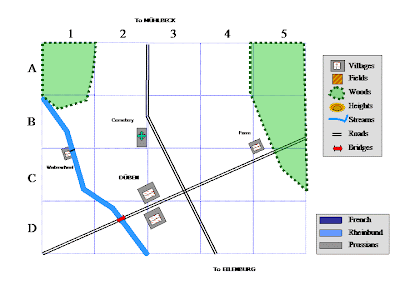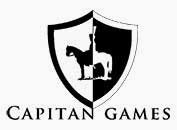In the first days of October 1813, the Blucher's Army of Silesia was put under the command of the Swedish Crown Prince, Bernadotte, and crossed the Elbe River at Wartenburg (see also the Wartenburg page at the main web site) thus placing itself near the Bernadotte's Army of the North. In order to achieve the junction of both forces, Blucher made a 'flank march' under the eyes of the Ney's Army of Berlin, routed recently in Gross-Beeren and Dennewitz.
 This dangerous situation was immediately spoted by Napoleon, that hurried up with the mauled Army of Berlin (VII, XI and IV Army Corps), other Army Corps (III, VI), the I, II and III Cavalry Corps and the Guard. The maneuver was discovered by Blucher, which crossed the Mulde River towards Bernadotte, instead moving back towards the Elbe River and his line of communications. This bold action sealed the fate of Napoleon and forced him to fight in Leipzig against a ring of converging Allied armies.
This dangerous situation was immediately spoted by Napoleon, that hurried up with the mauled Army of Berlin (VII, XI and IV Army Corps), other Army Corps (III, VI), the I, II and III Cavalry Corps and the Guard. The maneuver was discovered by Blucher, which crossed the Mulde River towards Bernadotte, instead moving back towards the Elbe River and his line of communications. This bold action sealed the fate of Napoleon and forced him to fight in Leipzig against a ring of converging Allied armies.
The Düben affaire took place in October 9, when the vanguard of Reynier's VII Corps, advancing by the left bank of the Mulde River, arrived to the bridge of Düben and ran into the village. Düben was the crossing point over the Mulde River assigned to Langeron by Blucher, but when the Allied outposts were alerted from the arrival of the french, Langeron hurried up by the right bank towards the next northern crossing point. The Russian rearguard, the Kapzevich's X Corps, scorting the heavy artillery, was almost catch up, and only the rapid reaction of that General stopped the pursuit saving time for the slow baggage columns. Incidentally, Blucher and Langeron avoided capture by only one half hour, because they were also staying at Düben.
This engagement is too small for Napoleon's Battles and it seems adequate for Lasalle, so it will be my next project.
Sources
- Correspondance of Napoléon Ier. Vol. 26. Paris. 1868
- Mémoires de Langeron, Général d'infanterie dans l'armée russe. L.G.F. Paris. 1909
- Mémoires du Maréchal Marmont Duc de Raguse (Vol IV). Paris. 1857
- Journal des opérations des IIIe and Ve Corps en 1813. G. Fabry. Paris. 1902
- Napoleon at Leipzig. The Battle of Nations 1813. G. Nafziger. Chicago. 1996
- The map is taken from the napoleon-series.org site
Nota bene. Again my acknowledge for my good friend Armand d'Arc, that kindly told me about this small combat
 Steven Smith of the Napoleon-Series Forum has found a Russian page (in Russian sorry!) about the changes in the Russian flags. It covers also the Napoleonic era, so it could be a good source of inspiration.
Steven Smith of the Napoleon-Series Forum has found a Russian page (in Russian sorry!) about the changes in the Russian flags. It covers also the Napoleonic era, so it could be a good source of inspiration. And for the Cossacks, go to The Cossacks
And for the Cossacks, go to The Cossacks















































